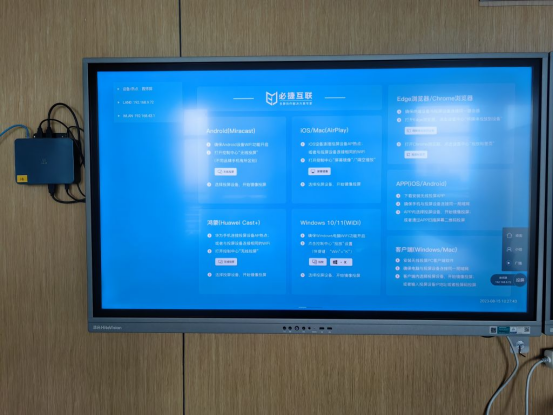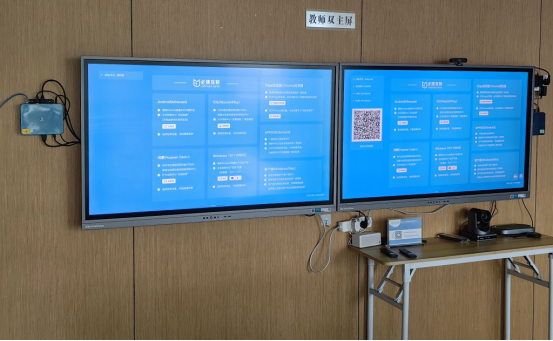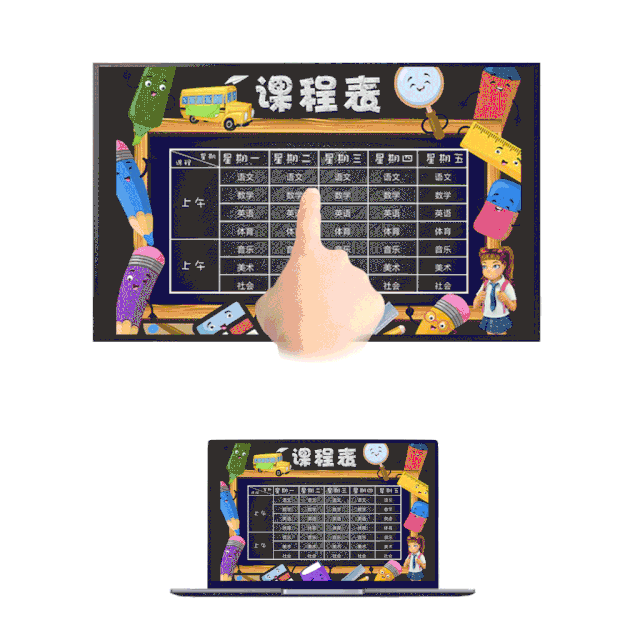Smart Classroom – Bijie Smart Classroom Solution Helps Universities Realize Smart Teaching
With the rapid development of information technology, the education industry is undergoing unprecedented changes. As an important component of educational technology, smart classrooms have become an important symbol of modern education. The Bijie Smart Classroom Projection Solution is based on this background, providing educational institutions with an efficient and convenient multimedia teaching environment.
Implementation of Bijie Smart Classroom Solution
- Hardware configuration
The hardware equipment of the Bijie Smart Classroom Projection Solution is mainly a multimedia collaboration system, which supports multiple projection protocols and can achieve fast connection between teaching terminals and display screens. - FUNCTION
The Bijie Smart Classroom Solution software has powerful functions, including real-time screen projection, screen recording, video conferencing, and multi screen interaction. Teachers can choose corresponding functions according to actual needs to achieve flexible and diverse teaching methods. - Plan deployment
During the deployment phase of the plan, the Bijie team will plan reasonably based on factors such as classroom layout and equipment quantity to ensure that the screen projection equipment can fully utilize its performance. At the same time, to ensure the stability and reliability of the plan, the Bijie team will also conduct strict quality testing and technical debugging on all equipment.
Overview of the functions of Bijie Smart Classroom Projection Solution
1. Wireless screen projection
The core equipment of the Bijie Interactive Display Subsystem is the Multimedia Collaboration System BJ66, which integrates wireless screen mirroring, whiteboard writing, multi machine linkage, and information publishing. It provides a multi screen collaboration solution for teachers and students to group screen mirroring and interactive sharing.
The Bijie Multimedia Collaboration System BJ66 provides the best BYOD wireless screen transfer in the industry, which is compatible with wireless projection standard protocols such as Airplay, Miracast, WiDi, DLNA, and Googlecast (mobile computers can be wirelessly projected without installing any software). It also provides the BJCast wireless screen transfer protocol (Bijie’s private screen transfer protocol, mobile phones/computers need to install client programs), and can support up to 6 simultaneous screen displays.

2. Multi machine linkage
The group discussion type smart classroom mainly achieves interaction between the main screen and group screens through the multi machine linkage function. The multi machine linkage function can broadcast the teacher’s main screen image to the group screen for one click display on the same screen, or drag and drop the group screen image to the classroom main screen for display or distribution, making it convenient for teaching teachers to share, transfer, and compare and evaluate courseware.
- One click broadcast

- Same screen drag and drop

- Drag and drop forwarding

3. Interactive control
For different smart classroom display environments, Bijie BJ66 provides a variety of interactive operation solutions. Whether it is a non OPS touch all-in-one machine, an OPS touch all-in-one machine, or a regular TV/projector, we can provide adaptive linkage solutions.
3.1 Supporting non OPS touch all-in-one machine
Non OPS touch all-in-one machine refers to a large screen that only provides display and touch functions. Users only need to use HDMI video cables and USB touch cables to connect the Bijie multi screen collaborative intelligent terminal with the touch screen, and can perform screen interactive operations and terminal configuration management on the touch screen.

The Bijie Multimedia Collaboration System has a sidebar control function. Clicking on the function buttons in the red area on the large screen allows for interactive operation and configuration changes to the multimedia collaboration system.
3.2 Supporting OPS touch all-in-one machine
OPS all-in-one machines generally use the Windows system as the main system. During the teaching process, the frequency of using Windows teaching software in the classroom is very high. The video output of BJ66 is an independent signal source, and it is necessary to switch the OPS all-in-one machine to HDMI display mode, which brings the problem of teachers needing to frequently switch signal sources. In response to this issue, Bijie Internet has specifically provided Windows based control interactive software and control API interfaces.

Functional features:
① Install interactive software on the Windows end, using a floating window form, providing one click broadcasting, same screen display, and screen projection device configuration functions;
② BJ66 and OPS touch all-in-one machines only require one data cable connection;
③ Keep the OPS computer and keep the teacher’s usage habits unchanged;
④ The screen projection and interactive functions are based on hardware boxes to avoid conflicts between interactive functions and third-party teaching software, as well as to avoid insufficient OPS performance;
⑤ The operation is based on OPS BJAPP/SDK, without the need to switch OPS signals;
⑥ Teachers and students do not need to install software on their phones and computers.
3.3 Supporting independent central control device (Android/Windows)
For application environments that use independent intelligent central control, Bijie can provide a multi screen interactive control APP or API interface to control BJ66’s signal switching, screen broadcasting and other interactive operation functions through the APP end.
Third party companies can integrate and adapt functions based on the Bijie Interactive Control API interface, and currently can adapt to Android and Windows platforms.

Functional features:
① The operational functions are fully integrated into the unified central control equipment for centralized management and control;
② Easy to integrate WebSocket interface, low integration development difficulty;
③ It can be integrated and docked with mobile central control screen, wall mounted central control, and intelligent podium.
4. Recording and broadcasting docking
BJ66 provides an RTSP interface that can be integrated with school recording and broadcasting systems. This function enables the audio and video of teaching projection to be recorded and stored, and through integration with the recording and broadcasting system, automated recording can be achieved without the need for additional manual operations. In this way, whether it is classroom teaching, experimental demonstrations, or other teaching activities, the entire process can be recorded, providing the school with detailed teaching process information, and providing valuable information for subsequent teaching evaluation, teaching reflection, and student review.

5. Screen mirroring and reverse control
BJ66 can provide screen mirroring and reverse control for Android and Windows devices. IOS and Mac OS devices currently do not support screen mirroring and reverse control.
- Android device screen mirroring reverse control
The reverse control of Android device screen mirroring is only effective in Miracast screen mirroring mode, and Android terminals need to support UIBC function (currently supported by Huawei, Samsung, and some high-end Xiaomi phones).
- Windows device screen mirroring reverse control
Windows device screen mirroring reverse control can be supported in both WiDi direct mirroring and PC client mirroring modes. After the mirroring content is displayed on the screen, clicking on the large screen display area will pop up a function button to activate the reverse control function.
Win10 computer WiDi reverse control needs to enable “Allow mouse, keyboard, touch, and pen input from this device”.
Windows computer client screen mirroring control.

- Group screen reverse control
When using the multi machine linkage function, the group screen can control the main screen of the classroom in reverse, allowing students to add annotations or make corrections to knowledge points in a timely manner, improving teaching interaction and learning efficiency.
6. Mirror display
By using mirror mode to copy the content of one device to other devices, multiple monitors can display the same image, achieving one projection and multiple views for clearer and more intuitive viewing. This mode is particularly suitable for teaching, demonstration and other scenarios. It can copy the content of the teacher’s main screen to the group screen, achieving the same screen display while also making the content display more concentrated and comprehensive. Facilitate teachers to share courseware, thereby improving teaching efficiency.
7. Weak network transmission
BJ66 can still maintain screen mirroring in the event of 10-20% network packet loss, and has considerable adaptability and stability. It also supports adjusting the screen resolution and visualizing the signal strength. Teachers can flexibly adjust the clarity and stability of screen mirroring according to their own needs and network status during the teaching process. At the same time, the real-time display of signal strength also allows teachers to intuitively understand the current network status, so that they can make corresponding teaching adjustments in a timely manner, ensure the smooth progress of screen casting, and avoid wasting valuable time in the classroom.
8. Electronic whiteboard and annotations
BJ66 has built-in electronic whiteboard and annotation functions, providing flexible writing and implementation of grading. Considering the demand for various paper-based applications such as complex formulas and graphics in actual teaching, the electronic whiteboard annotation function can ensure efficient collaboration and spontaneous expression of ideas and inspiration between teachers and students in the process of cooperative learning, collaborative exploration, and interactive teaching. Support multiple groups to discuss simultaneously, and multiple discussion groups in parallel can share presentations and circle annotations internally; Support collaborative punctuation, teachers can annotate the demonstration content with dots and distinguish them with different colored brushes. The intelligent writing function and multi screen interaction in the solution complement each other, allowing teachers, students, and groups to display their displayed content in a multi window manner at any time, annotate and analyze the displayed content, and broadcast and share it, effectively enriching the interactive methods of group teaching and collaborative learning.
9. Information Release
BJ66 supports wallpaper and subtitle push functions, and can customize image and letter scrolling playback during teaching activities. Information dissemination is convenient, fast, and accurate, eliminating the need for traditional information dissemination methods. It can be pushed in the form of images or text, including public announcements, exam information, schedules, and other materials.

10. USB file browsing
Teachers can insert a USB flash drive and directly browse, play, and edit teaching images, videos, and documents stored in the USB flash drive on BJ66 without the need for other external devices. Even if the teacher forgets or is unable to carry a computer or other teaching equipment, they can still use a USB flash drive for teaching.
11. Unified management
The BJ66 adopted in the plan supports remote unified management function. By deploying an independent management service platform, front-end devices can be centrally controlled and managed. It supports operation and maintenance personnel to remotely view device information through the network, set device configurations individually or in batches, real-time statistics of device working status, operation and maintenance data, etc., thereby achieving efficient and intelligent management of a large number of devices, greatly reducing management difficulty and costs.

The Bijie Smart Classroom Projection Solution provides educational institutions with an efficient and convenient multimedia teaching environment through advanced wireless projection technology and intelligent hardware devices. This plan has the characteristics of simple operation, strong interactivity, stability and reliability, and can significantly improve the quality and effectiveness of teaching. With the continuous deepening of educational informatization, the Bijie Smart Classroom Projection Solution will play a more important role in the future, helping the continuous progress and innovation of the education industry.